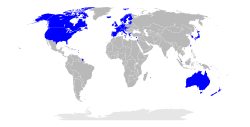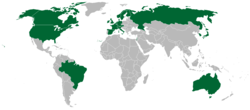Developed country
A developed country (also known as an industrialised country or more economically developed country (MEDC)) is a country that has more businesses and infrastructures (roads, airports, electricity, etc) than a developing country. The numbers most used for measuring economic growth is gross domestic product (GDP) and per capita income (average money per person). Others include the amount of industry, how much infrastructure there is, literacy, life expectancy and the basic standard of living. There is no exact way of saying what country is developed or developing. People often discuss the question of whose countries are the most developed ones,[1]
Developed countries have post-industrial economies, which means that the service sector becomes more important, and the industrial sector is less important. Service sector jobs are those where a person does something for another, like selling or fixing a product. Industry sector jobs are actually making a product, usually in a factory. In a developed country, industry jobs may be moved (outsourced) to less developed countries that pay workers less money. Developing countries may be in the process of industrialization (building the factories and infrastructure) and underdeveloped countries usually depend on agriculture, often subsistence farming.
The first industrialised country was the UK, followed by Belgium. Later industrialised countries were Germany, the US, France and other Western European countries. According to Jeffrey Sachs, the current split between the developed and developing world is mostly an event of the 20th century. [2]
Influence
According to the International Monetary Fund, developed countries supplied over half of the global GDP in 2010.[3] In 2012, the major advanced economies were the US, Japan, Germany, France, the UK, Italy, and Canada. These are also called the G7.[4]
The G7 has 10% of the world's population, but produces nearly 40% of the world's GDP.[5] They also control many of the economic decisions that affect the world.[6] The United Nations Security Council has five permanent members, four of those are in the G8 (G7 plus Russia).
Similar terms
Terms similar to developed country include advanced country, industrialised country, more developed country (MDC), more economically developed country (MEDC) (compared to less economically developed country(LEDC)), Global North country, first-world country, and post-industrial country.
Other ways to measure
Economic criteria are usually seen as most important. This includes income per capita (average money for each person). Countries with high GDP per capita and mature industrialization are described as developed countries. But modernization is not always seen as the only way to measure progress.
Recently, another measure, the Human Development Index (HDI), which combines jobs, income, along with access to medicine, life expectancy, and education has become prominent. The UN HDI is measures a country's level of human development. While there is a strong connection between a high HDI score and a prosperous economy, it is not always the case. The top 47 countries by HDI have scores ranging from 0.793 in Barbados to 0.955 in Norway. Many countries having an HDI of 0.788 and over (as of 2010), are also listed by IMF or CIA as "advanced" (as of 2009). The country of Bhutan started the idea of Gross National Happiness (GNH), to measure how happy people actually are. They felt the GNH was as important as GDP, and this idea has spread beyond Bhutan.
Developed Country Media
The world map representing Human Development Index categories (based on 2023 data, published in 2025)Template:Legend-col*
Member nations of the Development Assistance Committee
Permanent members of the Paris Club
References
- ↑ Developed Economy Definition. Investopedia (2010-04-16). Retrieved on 2013-07-12.
- ↑ Sachs, Jeffrey (2005). The End of Poverty. New York, New York: The Penguin Press. ISBN 1-59420-045-9.
- ↑ IMF GDP data (September 2011)
- ↑ "Gross domestic product, current prices & Gross domestic product based on purchasing-power-parity (PPP) valuation of country GDP". World Economic Outlook Database, April 2012. International Monetary Fund. April 2012. Retrieved 2016-10-26.
- ↑ "Group of 7 Countries". NationMaster. Retrieved 26 October 2016.
- ↑ "G7, G8, G20". European Commission. Retrieved 26 October 2016.





